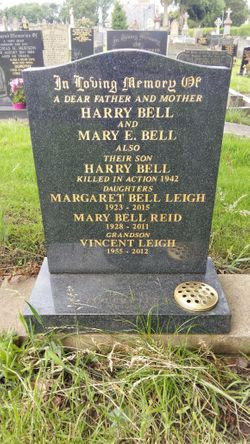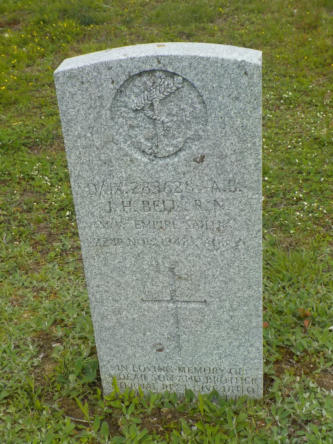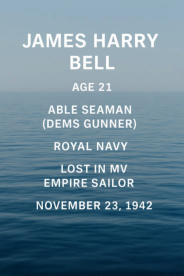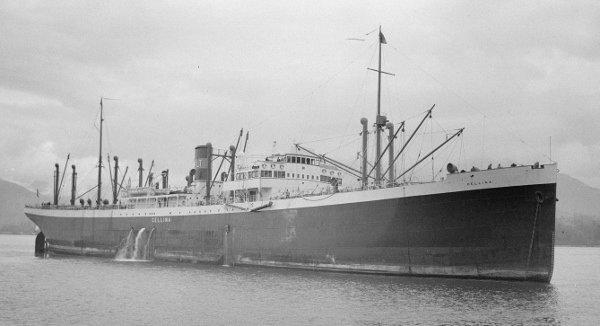
copyright © Wartime Heritage Association
Website hosting courtesy of Register.com - a web.com company
Wartime Heritage
ASSOCIATION
Remembering World War II
James Harry Bell
D/JX 283628. HMS President III. Royal Navy
Able Seaman (DEMS Gunner)
HMS President III. Royal Navy
Lost in MV Empire Sailor
January 5, 1921
Stalybridge, Cheshire, England
Single
November 23, 1942
21
Mount Olivet Cemetery, Halifax, Nova Scotia, Canada
Sec. 3 Range 2. Grave 35
James Harry Bell was the only son of Harry Bell (1896-1958) and Mary Elizabeth (Kenworthy) Bell (1895-
1973) and the brother of Margaret Bell (1923-2015) and Mary Bell (1928-2011) of Stalybridge, Cheshire,
England.
His name is included on a family grave stone with those of his parents and sisters in the Dukinfield
Cemetery and Crematorium, Dukinfield, Metropolitan Borough of Tameside, Greater Manchester, England.
James Bell died of poisoning from the inhalation of phosgene gas after the torpedoing of the MV Empire
Sailor on November 23, 1942. James Bell was aged 21, a Royal Navy DEMS gunner assigned to the MV
Empire Sailor as part of the Defensively Equipped Merchant Ships (DEMS) program. He was rescued by
HMCS Minas after the sinking but died en route to hospital in Halifax, Nova Scotia. He is the only casualty
of the sinking that was not buried at sea.
James Bell was buried in the Mount Olivet Cemetery, Halifax, on November 27, 1942.
The Loss of MV Empire Sailor
On the night of November 21, 1942, the British merchant vessel MV Empire Sailor was torpedoed by
German submarine U-518 while sailing with Convoy ON-145 in the North Atlantic, approximately 190 miles
south west of Cape Race.
Originally built in 1926 and seized as a war prize in 1940, the Empire Sailor was operated by the Ministry
of War Transport and was en route from Liverpool to St John, New Brunswick, via Halifax, Nova Scotia.
Unbeknownst to most of her crew, the ship carried a highly dangerous cargo: 460 tons of phosgene bombs,
100 tons of cyanide, and 60 tons of mustard gas. When the torpedo struck Hold No. 2, it ruptured the
chemical munitions, releasing a lethal cloud of toxic gas.
Survivors initially believed the escaping vapour was steam, but it soon became clear that the gas was far
deadlier. Though the initial explosion killed only a few, the delayed effects of the phosgene gas proved
catastrophic. Many crew members who had appeared unharmed began to cough, froth at the mouth, and
collapse in agony hours later.
Of the 57 crew and gunners aboard, 22 died from the attack or subsequent gas exposure. Survivors were
rescued by HMCS Timmins and HMCS Minas, but several succumbed en route to Halifax and James Harry
Bell after arrival on route to Camp Hill Hospital.
Phosgene gas, a colourless and suffocating chemical agent, has a deceptively mild odour reminiscent of
freshly cut hay. Victims often showed no immediate symptoms, only to suffer severe pulmonary edema
hours later. The gas damages the lungs, leading to fluid build-up and eventual suffocation.
Given the secrecy surrounding chemical weapons logistics during the war, only senior officers aboard the
MV Empire Sailor were aware of the nature of the cargo. Tragically, this contributed to the high number of
deaths from phosgene exposure after the torpedo strike. 17 crew members and three gunners died from
phosgene gas poisoning.
Extract from a report to the Admiralty by the commander of HMS Wanderer:
No precautions had been taken onboard, apparently only the senior officers being aware of the nature of
the cargo. If the crew had carried ordinary service respirators they would have been adequately
protected. These respirators were not even carried on board. It is submitted that these facts should be
made the subject for a full enquiry, as it seems that there are some who do not realize that our Merchant
Navy have enough to put up with without having to die horrible deaths caused by their own cargo. The
effect of this occurrence on the morale of Merchant Seamen in Halifax can readily be imagined.
James Harry Bell


Name:
Service Number:
Rank:
Service:
Date of Birth:
Place of Birth:
Marital Status:
Date of Death:
Age at Death:
Cemetery
Reference:
Sources:
Commonwealth War Graves Commission
findagrave
uboat.net
Nova Scotia Archives - Death Certificate






- World War I - Menu
- WWI Stories and Articles
- Photos - Yarmouth Soldiers
- Selection of World War I Songs
- WWI Casualties of Yarmouth, NS
- Those Who Served - Yarmouth, NS
- WWI Casualties Digby Co. NS
- WWI Casualties Shelburne Co. NS
- Merchant Mariners (1915) Yarmouth, NS
- Canadian Forestry Corps - Non Yarmouth Birth/Residence Enlistments
- US Draft Registry - Yarmouth NS Born


- World War II - Menu
- WWII Stories and Articles
- Telegraphist Air Gunners
- WWII Casualties of Nova Scotia
- US Casualties with NS Connection
- Far East/Pacific Casualties with NS Connection
- Merchant Navy Casualties Nova Scotia
- Nova Scotia WWII Casualties Holten Canadian War Cemetery
- D-Day Casualties - Nova Scotia
- CANLOAN Program Casualties - Nova Scotia
- Battle of the Bulge Casualties - Nova Scotia
- WWII Casualties Yarmouth NS
- Yarmouth Casualties - RCAF RAF Canadian Army WWII
- Yarmouth Co., Marriages WWII
- Casualties Non-Born/Residents with Connection to Yarmouth Co., Nova Scotia.
- WWII Casualties Digby Co., NS
- Non-Nova Scotian WWII Casualties Buried in Nova Scotia
- WWII RCAF Casualties Aged 16-18
- Brothers/Sisters Who Served - World War II













